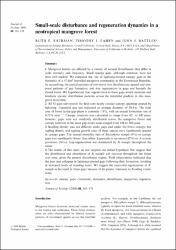Mostrar el registro sencillo del ítem
Small-scale disturbance and regeneration dynamics in a neotropical mangrove forest
| Autor | Sherman, Ruth E. | |
| Autor | Fahey, Timothy J. | |
| Autor | Battles, John J. | |
| Fecha de admisión | 2024-01-04T19:47:11Z | |
| Fecha disponible | 2024-01-04T19:47:11Z | |
| Año | 2000 | |
| Citación | Sherman, R. E., Fahey, T. J., & Battles, J. J. (2000). Small‐scale disturbance and regeneration dynamics in a neotropical mangrove forest. Journal of Ecology, 88(1), 165-178. Recuperado de: | es |
| URI | https://bvearmb.do/handle/123456789/3832 | |
| Sinopsis | Mangrove forests are affected by a variety of natural disturbances that differ in scale, intensity and frequency. Small canopy gaps, although common, have not been well studied. We examined the role of lightning-created canopy gaps in the dynamics of a 47-km2 intertidal mangrove community in the Dominican Republic, by quantifying the spatial patterns of overstorey tree distributions, spatial and temporal patterns of gap formation, and tree regeneration in gaps and beneath the closed forest. We hypothesized that regeneration in these gaps would maintain and reinforce species’ distribution patterns across the intertidal gradient in this mangrove ecosystem. All 52 gaps surveyed in the field were nearly circular canopy openings created by lightning. Expanded gap size indicated an average diameter of 30.4 m. The total area of forest in the gap-phase is currently 1.9%, with an annual formation rate of 0.23% year−1. Canopy turnover was calculated to range from 421 to 842 years; however, gaps were not randomly distributed across the mangrove forest and canopy turnover in the most gap-prone areas ranged from 194 to 386 years. Seedling density was not different under gaps and under the forest canopy, but sapling density and sapling growth rates of three species were significantly greater in canopy gaps. The annual mortality rate of Rhizophora mangle (9%) in canopy gaps was significantly lower than either Laguncularia racemosa (32%) or Avicennia germinans (56%). Gap regeneration was dominated by R. mangle throughout the forest. The results of this study do not support our initial hypothesis but suggest that the distribution and abundance of R. mangle will increase throughout the forest over time, given the present disturbance regime. Field observations indicated that the peat mat collapses in lightning-created gaps following their formation, resulting in increased levels of standing water. We suggest the successful regeneration of R. mangle is favoured in these gaps because of its greater tolerance to flooding conditions. | es |
| Idioma | English | es |
| Publicado | Journal of Ecology, 88(1), 165-178 | es |
| Derechos | © 2000 BritishEcological Society. | es |
| Materia | Recursos naturales - República Dominicana | es |
| Materia | Flora ─ República Dominicana | es |
| Materia | Hábitats y especies | es |
| Título | Small-scale disturbance and regeneration dynamics in a neotropical mangrove forest | es |
| dc.identifier.doi | https://doi.org/10.1046/j.1365-2745.2000.00439.x | |
| Tipo de material | Article | es |
| Tipo de contenido | Scientific research | es |
| Acceso | Open | es |
| Audiencia | Technicians, professionals and scientists | es |
Ficheros en el ítem
Este ítem aparece en la(s) siguiente(s) colección(es)
-
Investigación ambiental [1725]


